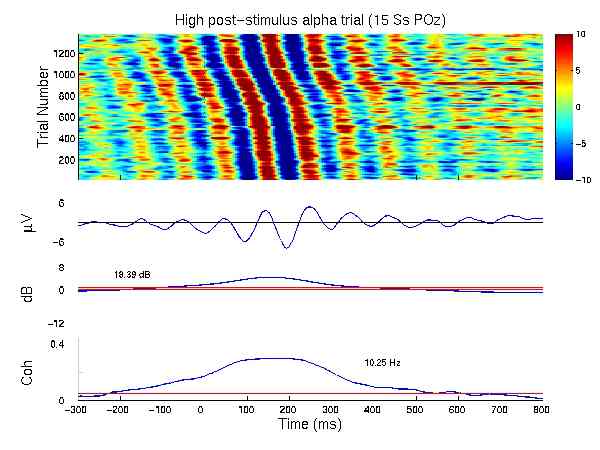
Figure 1. ERP image of 1300 color-coded single trials from 15 Ss in a visual selective attention experiment, sorted by alpha phase in a 300-msec wide post-stimulus window. Note the non-uniform phase distribution. Top trace: the trial average. Note the relationship to the trial distribution. Middle trace: Time course of alpha amplitude. The post-stimulus peak was produced by rejecting trials with low post-stimulus alpha power. Bottom trace: Time course of Inter-Trial Coherence (ITC), measuring phase locking at (10.25 Hz) to stimulus onsets (at time 0).
That is, contrary to common assumption evoked responses may not be produced by brief synchronous neural activations in brain areas briefly engaged in successive stages of stimulus-related information processing. Rather, every feature of an evoked response may actually be produced by event-related changes in the autocorrelation and cross-correlation structure of ongoing EEG processes, each reflecting synchronous activity occurring continuously in one or more brain regions, or by more subtle perturbations in their dynamics. We will present evidence, derived by Independent Component Analysis (ICA), single-trial visualization, and time/frequency analysis, that most or all features of averaged responses following target and nontarget stimuli in a visual selective attention experiment may be reinterpreted as artifacts of averaging applied to event-related changes in the dynamics of ongoing EEG processes. These can be measured as event-related changes in the phase distribution of the EEG (or MEG) time locked to experimental events (see Figure 1).
Historically, the focus on response averaging has contributed to an unnatural separation between the innately related sub-fields of ERP and EEG (or ERF and MEG) research, and has increased the conceptual separation between human electrophysiology and animal neurophysiology (supported as well by the neglect of local field potentials by neurophysiologists who record them). Currently, however, a new field is emerging that we propose to call cognitive event-related brain dynamics. Ever-increasing computational resources allow new generations of cognitive neuroscientists to study the dynamics of the scalp-recorded electromagnetic field using combinations of complex and sophisticated methods including source imaging, time/frequency analysis, event-related coherence, non-linear dynamics and independent component analysis. Applying these new techniques reveals that the EEG and MEG data contain a much unmined information about mechanisms of neural synchronization within and between brain areas. Further, this information appears to be convergent with new findings both in cellular neurophysiology and hemodynamic brain imaging. The new approach also makes feasible new experimental paradigms for studying the macroscopic brain dynamic substrates of a wide range of human cognitive processes.
: